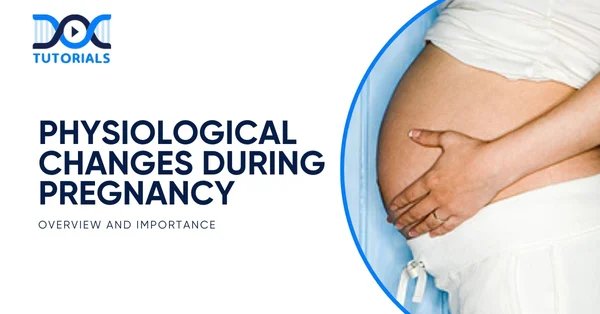Physiological Changes During Pregnancy: Overview and Importance

Pregnancy is a dynamic and complex biological state. Thus, individuals generally experience a series of physiological changes during pregnancy across multiple body systems. These alterations are essential in foetal development, making the maternal body ready for birth and the overall well-being of the mother and the foetus.
What are Physiological Changes During Pregnancy?
The following are physiological changes in pregnancy:
- Hormonal Changes
There are significant hormonal changes during pregnancy, and various hormones promote foetal and placental growth as well as prepare the body to give birth to the child. Once formed, the placenta becomes the main source of key hormones:
- Progesterone
Progesterone plays a crucial role in sustaining pregnancy. It assists in keeping the uterus lining in place and hinders premature uterine contractions. This hormone also decreases the tone of the smooth muscles. In addition, progesterone supports breast development, promotes fat storage through its effect on metabolism, and raises body temperature slightly.
- Oestrogen
Oestrogen is first secreted by the corpus luteum and later by the placenta. Its levels gradually increase as pregnancy progresses. This hormone stimulates the enlargement of the uterus by promoting blood vessel dilation and increasing uterine blood flow. Towards the end of pregnancy, it prepares the uterus for labour by counteracting the muscle-relaxing effects of progesterone.
- Human Chorionic Gonadotrophin (hCG)
It is the earliest hormone secreted by the developing placenta and is the hormone detected by standard pregnancy tests. hCG signals the body that pregnancy has begun by maintaining the production of progesterone during the early stages.
- Relaxin
Relaxin plays an important role towards the end of pregnancy by softening the cervix and loosening the pelvic ligaments. This facilitates the process of labour by enabling the pelvis to accommodate childbirth more easily.
- Changes in the Hair, Skin, and Nails
Most women often report developing thick hair during pregnancy as a result of the hormonal changes. There is also the possibility of excess hair on the facial region, which may be unwanted on the arms and back. Such changes are also seen to recur during future pregnancies or hormonal birth control use.
- Hair and Nail Changes
During pregnancy, a woman would experience thicker hair growth owing to the changes in hormones. Unnecessary hair on the face, arms or back may also become a problem for some people. On the other hand, hair thinning or shedding can occur, especially after delivery. Nail growth may speed up, but nails can become brittle or prone to breaking.
- Melasma and Skin Discolouration
Dark patches may appear on areas like the face, areolas, and abdomen due to increased pigmentation. Melasma is widespread and may become worse when exposed to the sun. Its severity can be lessened by the daily use of a good sunscreen. Most pigmentation changes fade after childbirth.
- Stretch Marks
Stretch marks occur as a result of extreme growth of the skin and hormonal changes, which cause stretching of the skin. During the third trimester, they appear on the abdomen and the breasts. While they may not disappear completely, they usually fade over time. Moisturisers can ease itching and help soothe the skin.
- Changes in Moles and Freckles
Hormonal shifts can cause moles, freckles, or birthmarks to darken. Though usually harmless, any sudden changes in size, colour, or shape should be checked by a dermatologist. Some pigment changes may be permanent, so it is wise to monitor your skin during pregnancy.
- Sensory Changes
Pregnancy often brings noticeable changes to a woman’s senses, including sight, taste, and smell, due to hormonal and physiological shifts.
- Vision Changes
Some women may notice changes in their eyesight during pregnancy, such as mild blurriness or increased nearsightedness. Contact lenses may not be so comfortable to use, and the intraocular pressure may increase.
Nevertheless, vision usually returns to normal after childbirth. Women with conditions like gestational diabetes or preeclampsia may face rare complications, such as vision loss or retinal issues, and should consult their doctor if symptoms arise.
- Taste and Smell Changes
Pregnant women often develop new taste preferences, with a tendency to enjoy sweeter or saltier foods. Changes in taste sensitivity, such as reduced ability to taste, are more common in the first trimester. A metallic taste in the mouth is also frequently reported, which can contribute to nausea and might suggest a nutrient imbalance.
- Changes in the Reproductive System
During pregnancy, the reproductive system undergoes extensive physiological adaptations to support the development and nourishment of the growing foetus.
- Uterine Expansion and Growth
The uterus enlarges significantly throughout pregnancy to accommodate the developing foetus. This process is aided by the relaxation of the uterine smooth muscles and the formation of additional uterine tissue. As the uterus expands, there is also a marked increase in blood flow to meet the metabolic demands of both the uterus and the foetus.
- Cervical Softening and Effacement
The cervix undergoes important structural changes in preparation for labour and delivery. It becomes more flexible and less firm due to the breakdown of collagen and an increase in cervical mucus. The cervix gradually shortens and thins out, which helps facilitate a smoother delivery during labour. These changes ensure that the birth canal is adequately prepared for the passage of the foetus.
- Changes in Ovarian Function
As pregnancy progresses, the placenta assumes responsibility for the production of oestrogen and progesterone, thereby reducing the hormonal output required from the ovaries. The ovaries still secrete androgens, which are converted into oestrogens by the placenta, supporting hormonal balance during pregnancy.
- Cardiovascular and Renal Changes
During pregnancy, the cardiovascular and renal systems adapt significantly to meet the growing metabolic needs of both the mother and the developing foetus.
- Increase in Blood Volume and Cardiac Output
There is a substantial rise in blood volume during pregnancy, accompanied by a marked increase in cardiac output. Maternal blood volume expands by around 40 to 50%, with most of this increase taking place in the second trimester.
On the other hand, cardiac output rises by approximately 30 to 50%, largely during the first trimester. This increase is achieved through a combination of a higher heart rate and greater stroke volume, enabling more efficient circulation to meet the needs of the mother and foetus.
- Alterations in Blood Pressure and Vascular Resistance
Pregnancy induces notable changes in blood pressure and systemic vascular resistance. Blood pressure typically drops in early pregnancy, reaching its lowest point in the second trimester, before gradually returning to pre-pregnancy levels by the third trimester. Systemic vascular resistance is reduced, allowing for enhanced blood flow to essential organs, including the uterus, to support foetal development.
- Enhanced Renal Blood Flow and Glomerular Filtration Rate (GFR)
The kidneys undergo functional changes to accommodate the increased workload during pregnancy. Renal perfusion rises by roughly 30–50%, especially during the second trimester. The GFR increases by about 50%, facilitating more efficient removal of metabolic waste products from the maternal and foetal systems.
Importance of Recognising Physiological Changes During Pregnancy
Recognising physiological changes during pregnancy is essential for several important reasons:
- Effective Antenatal Care
Awareness of the normal physiological adaptations helps healthcare professionals offer suitable monitoring and management throughout pregnancy.
- Early Detection of Complications
Identifying deviations from expected changes allows for early recognition of potential complications and timely medical intervention.
- Enhancing Maternal Health and Safety
Proper knowledge of such changes allows medical workers to improve maternal health, decrease the risk of negative outcomes of the pregnancy and secure appropriate outcomes for the mother and the child.
FAQs About Pregnancy Changes
- Which hormones play a key role during pregnancy?
Notable examples of pregnancy hormones are progesterone, oestrogen, human chorionic gonadotrophin (hCG) and relaxin. They control everything, including the growth of the uterus and body metabolism.
- Do skin and hair change during pregnancy?
Yes, skin and hair change during pregnancy. Many women notice thicker hair, faster nail growth, and skin changes like melasma, stretch marks, and darkening of moles or freckles.
- How does pregnancy affect the heart and kidneys?
During pregnancy, the body redistributes the increased blood volume, cardiac output, renal blood flow, and glomerular filtration rate in order to satisfy the increased metabolic requirement.
Conclusion
Physiological changes during pregnancy are fundamental adaptations that make the body accommodate the developing foetus and become ready to deliver a healthy child. Even though these changes can affect many systems, their understanding will help you distinguish between the normal reactions and complications that could develop.
In the case of NEET PG aspirants, it is important to have a right understanding of such physiological changes so as to guarantee appropriate diagnosis and management of patients. DocTutorials provides in-depth study resources and professional advice in the form of concise video lectures, mock tests, doubt-clearing sessions and more, which help you cover such high-yield topics with ease.
Explore our NEET PG course to strengthen your exam preparation and boost your clinical knowledge!
Latest Blogs
-

NEET PG Exam 2025- Date, Pattern, Marking Scheme, Subject Wise Weightage, and Exam Mode
NEET PG Exam 2025 is the ultimate gateway for medical graduates aspiring to pursue postgraduate courses in medicine, including MD,…
-

INI CET Exam 2025: Your Roadmap to Success – Key Topics, Strategies, and Lessons from Last Year’s Papers
The INI CET exam is more than just a test; it’s a significant milestone for many medical students aiming to…
-

INI CET Exam Success: Previous Year Question Papers & Ultimate Guide – INI CET PYQ
One can feel overwhelmed while preparing for the INI CET (Institute of National Importance Combined Entrance Test). A vast syllabus,…




